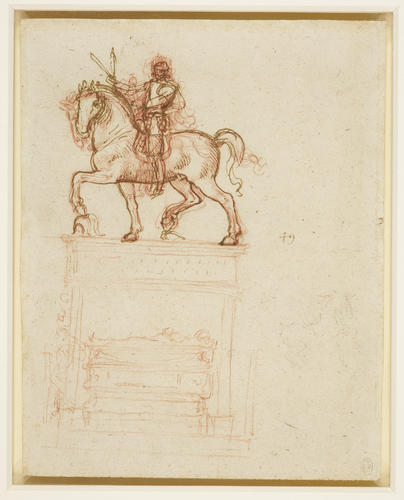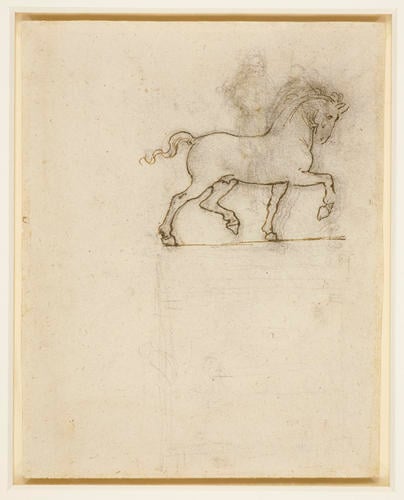-
1 of 253523 objects
Recto: A study for the Trivulzio monument. Verso: A study for an equestrian monument Recto: c.1510-12 and c.1517-18. Verso: c.1517-18
Recto: Red chalk, pen and ink. Verso: Black chalk, gone over in part with pen and ink | 21.7 x 16.9 cm (sheet of paper) | RCIN 912356

Leonardo da Vinci (1452-1519)
Recto: A study for the Trivulzio monument. Verso: A study for an equestrian monument Recto: c.1510-12 and c.1517-18. Verso: c.1517-18

Leonardo da Vinci (1452-1519)
Recto: A study for the Trivulzio monument. Verso: A study for an equestrian monument Recto: c.1510-12 and c.1517-18. Verso: c.1517-18


-
Recto: a study for the Trivulzio Monument, with the base and sarcophagus vaguely indicated; a vague sketch of a horse and rider, lower right. Verso: a partial tracing through from the recto, with the suggestion of a rider and a pedestal. Probably for an undocumented French monument, and done ten years after the recto. Melzi's number 49.
While in the service of Ludovico Sforza around 1490, Leonardo had spent almost ten years working on a huge equestrian monument to Ludovico’s father, only for the project to be abandoned. Twenty years later he designed another equestrian monument, to Gian Giacomo Trivulzio, the military commander who had led the French in the invasion of Milan in 1499. The monument, seen here in essentially its final form, was to consist of a bronze horse and rider surmounting a marble architectural framework housing Trivulzio’s sarcophagus. Leonardo’s detailed costing for the design survives, but there is no evidence that he carried out any physical work on the monument.
Leonardo traced through the drawing on the other side of the sheet, but the style of the vaporous black chalk and heavy pen lines seems much later. In his last years in France, Leonardo worked on the design of a final equestrian monument, probably to the French king. It seems therefore that he revisited his earlier designs for the Trivulzio monument, as a starting point for his work on the new monument – which likewise remained unexecuted.
Text adapted from Leonardo da Vinci: A life in drawing, London, 2018Provenance
Bequeathed to Francesco Melzi; from whose heirs purchased by Pompeo Leoni, c.1582-90; Thomas Howard, 14th Earl of Arundel, by 1630; probably acquired by Charles II; Royal Collection by 1690
-
Creator(s)
Acquirer(s)
-
Medium and techniques
Recto: Red chalk, pen and ink. Verso: Black chalk, gone over in part with pen and ink
Measurements
21.7 x 16.9 cm (sheet of paper)